After a disappointing campaign, Liverpool will need to improve in several areas if they are to get back to challenging at the top of the Premier League.
Following Liverpool’s Champions League final defeat to Real Madrid in May 2022, manager Jürgen Klopp was bullish.
“I have a strong feeling we will come again. The boys are competitive. We will have an outstanding group next season,” he said. “Where is it [the final] next season? Istanbul? Book the hotel.”
Unless Reds fans fancied spending a few days hanging out with Manchester City and Inter Milan supporters, they will have had to cancel those bookings.
The warning signs for what was to come in the 2022-23 season were on show in their next Champions League appearance. Their opening group game saw them overwhelmed by Napoli at the Stadio Diego Armando Maradona. Granted, it was perhaps not appreciated just how good Luciano Spalletti’s eventual Serie A champions were at the time, but the way Liverpool were torn apart in that 4-1 defeat in September suggested they were far from their usual selves.
They were ultimately knocked out by Real Madrid, again, in the last 16, but it was the Premier League where Liverpool’s drastic dip was most evident.
The hangover of narrowly missing out on an unprecedented quadruple a few months earlier seemed obvious. Manchester City denied them the Premier League title with a final-day comeback against Aston Villa, while Liverpool had largely dominated the Champions League final only to find Thibaut Courtois in inspired form in the Real goal. They still won both the League Cup and FA Cup, and the loss of Sadio Mané to Bayern Munich was in theory rectified by the arrival of Darwin Núñez from Benfica.
Their hopes of challenging for the Premier League title again though were basically over before the end of August. Their impressive performance in the 3-1 victory over Man City in the Community Shield proved how little that fixture matters when it comes to judging a team’s readiness for the campaign, as they went on to draw two and lose one of their first three league games, including a 2-1 defeat and insipid performance at Manchester United, who had themselves started with two losses under new boss Erik ten Hag.
It went on to be an inconsistent and trophyless season, peppered with seemingly random bursts of their best including a 9-0 thrashing of Bournemouth and 7-0 hammering of Man Utd. Only a resurgence in the last nine league games rescued what could have been an almost historically bad final position, though it was too late to claw back a place in the top four.
So where exactly did things go wrong for Liverpool? We’ve looked at some interesting numbers from their 2022-23 campaign to see where improvements need to be made.
- Away Day Struggles
Having lost only two of their 38 league games in 2021-22, Liverpool were beaten nine times a season later. Of those defeats in 2022-23, eight came on the road, winning just six of their 19 games away from home.
In fact, Klopp’s side lost the same tally of away games in 2022-23 as they did in 2019-20, 2020-21 and 2021-22 combined (eight), with this their lowest number of points won in away games across a league season since winning 18 in 2010-11.
They even ended the campaign with a negative goal difference on their travels (-1), conceding 30 times – as many as Everton and more than Crystal Palace, Chelsea, Brentford and Fulham.
Those figures looked even worse before early April. Liverpool eventually found their groove to win three and draw two of their last five away games, meaning they had before that point lost eight of their first 14 (W3 D3).
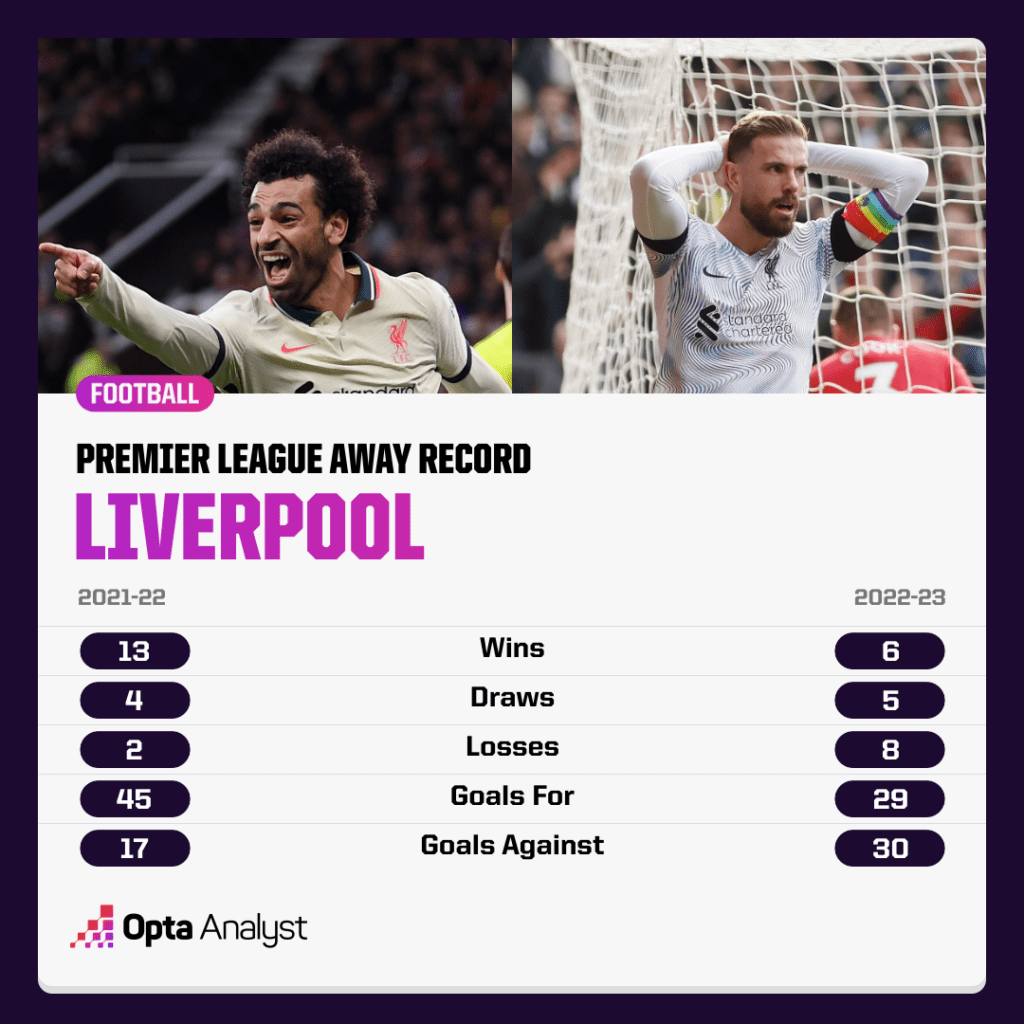
They also didn’t win an away game against a team in the bottom half until their 6-1 thrashing of Leeds United on 17 April, which takes us on to…
- Bottom Feeders
The secret to any successful season is regularly beating the teams near the bottom of the table. In 2021-22, Liverpool’s record against the bottom half saw them accumulate a near-perfect 58 points from 20 games (W19 D1 L0). This season they managed 36 points (W10 D6 L4), which would have been worse had it not been for that late turnaround in form.
Their first 15 games against bottom-half sides brought just 23 points (W6 D5 L4), and while we’ve already mentioned the lack of an away victory against a bottom-half team before their trip to Leeds, Cody Gakpo’s opener at Elland Road was actually their first goal in an away game against a team that finished in the Premier League’s bottom 10. They had previously failed to score in trips to each of Everton, Nottingham Forest, Wolves, Crystal Palace, Chelsea and Bournemouth.
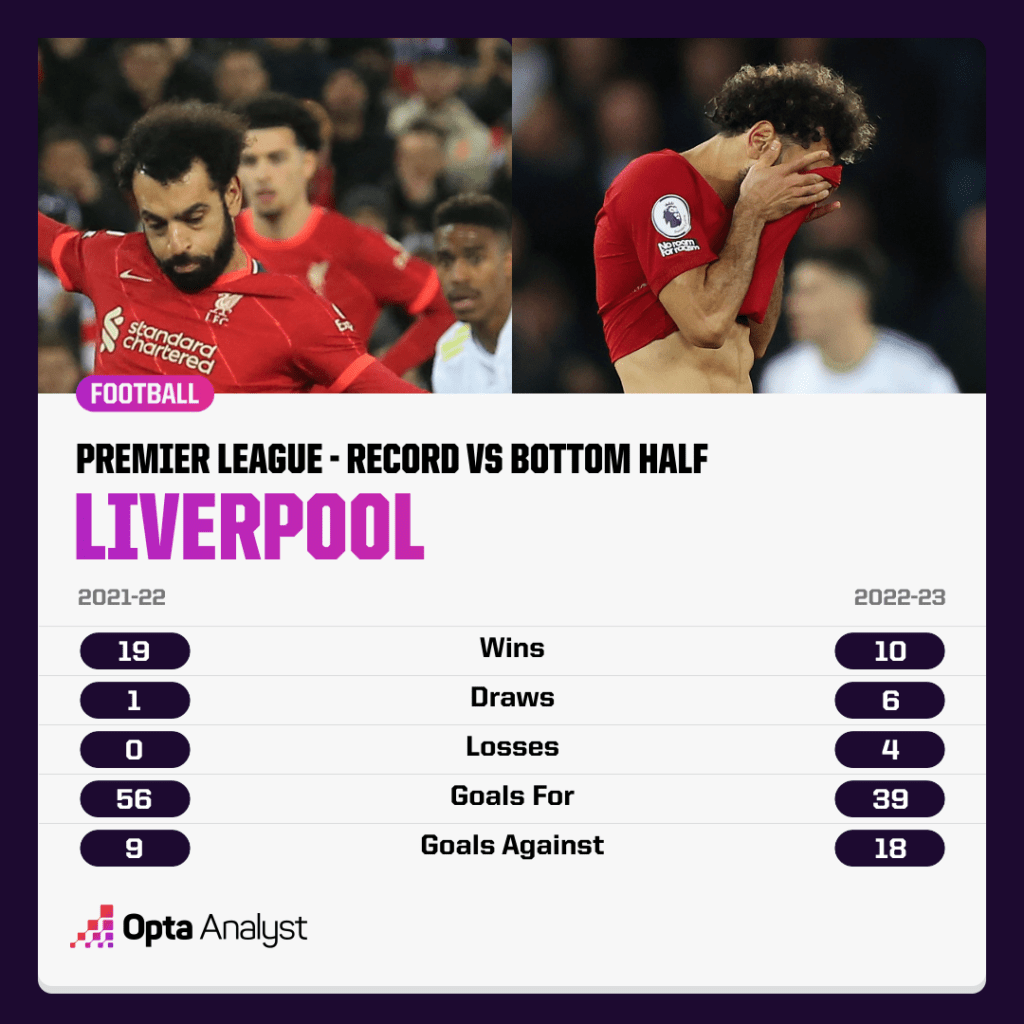
Late-season wins against Leeds, West Ham and Leicester City improved that record, but Liverpool will undoubtedly need to get back to putting such teams away with regularity next season.
- Big Chance Blues
It’s not exactly rocket science to say that to be successful in football, you need to take your chances (though admittedly, rocket science isn’t about football. It’s about rockets).
Liverpool remained a creative force despite losing Mané, while also being without Luis Díaz and Diogo Jota for a significant chunk of the season through injury. Only Man City (132) created more big chances than their 125 in the Premier League, but it was the finishing of those chances that let Klopp’s men down.
Only five teams had a worse conversion rate than their 37.6%, with Arsenal scoring two more big chances than Liverpool’s 47 despite creating 26 fewer overall. The biggest culprits were Mohamed Salah and Núñez, who missed 20 big chances each in the league. In fairness to the Egyptian, he also took 14 of those opportunities, while the Uruguayan only managed to convert seven, or just 25.9%.
That Leeds win in April also featured Jota scoring his first goals of the season, starting a run of form that saw him hit seven in the last nine games. Overall, he scored five and missed 10 big chances across the season (33.3%), while one of Liverpool’s main threats from set-pieces also struggled. Virgil van Dijk scored just one out of five big chances, compared to two out of three the season before. In fact, of the 10 players to have at least three big chances in the Premier League in 2021-22, only Jota scored fewer than half (13/27). In 2022-23, eight players had three or more big chances, of which only Roberto Firmino scored more than half (8/14), showing that wastefulness spread pretty much throughout the team.
Gakpo showed promise after arriving from PSV Eindhoven in January and Jota improved in the last few games when he got up to speed after his calf injury. Díaz had his season hugely disrupted by a knee injury, but Klopp will be hoping he can stay fit and get back to the form that saw him score 14 goals in 18 league games for Porto in the first half of 2021-22 before his move to Liverpool. Similarly, if Núñez can get back to the lethal finisher who scored 21 from 35 big chances (60%) in the Primeira Liga for Benfica in 2021-22, goals shouldn’t be as much of an issue next season.
Speaking of goals, it was another productive campaign for Salah. He managed 30 in all competitions, while he registered 31 goal involvements in the Premier League (G19 A12). Only Erling Haaland (23.1) had higher non-penalty expected goals (xG) total than Salah (18.5) in the league, while for a player who is often labelled selfish, only six players recorded higher expected assists (xA) than his 7.2.
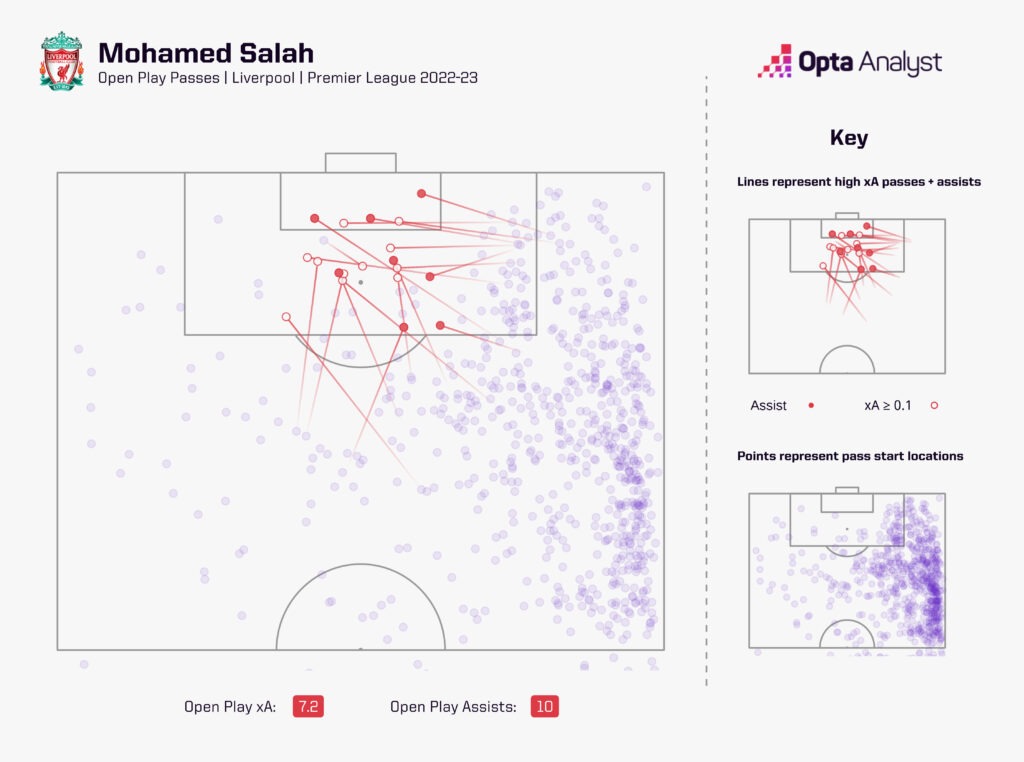
There is still the other end of the pitch to consider, though.
- Chance Concession
Liverpool weren’t just less efficient in attack, they were also leaky at the back. They allowed 370 shots at their goal in the Premier League last season, 73 more than the previous campaign and the most in a full season since Klopp’s arrival in 2015. It wasn’t just the number of chances against, though. It was the quality of them.
By the end of the season, 27.8% of shots Liverpool faced had been big chances, comfortably the most in the Klopp era. In fact, after facing 53 big chances in 2021-22, the fifth fewest in the league, Liverpool faced almost double (103) in 2022-23, the third most behind only Leeds and Fulham (both 112), showing just how open the Reds were on too many occasions.
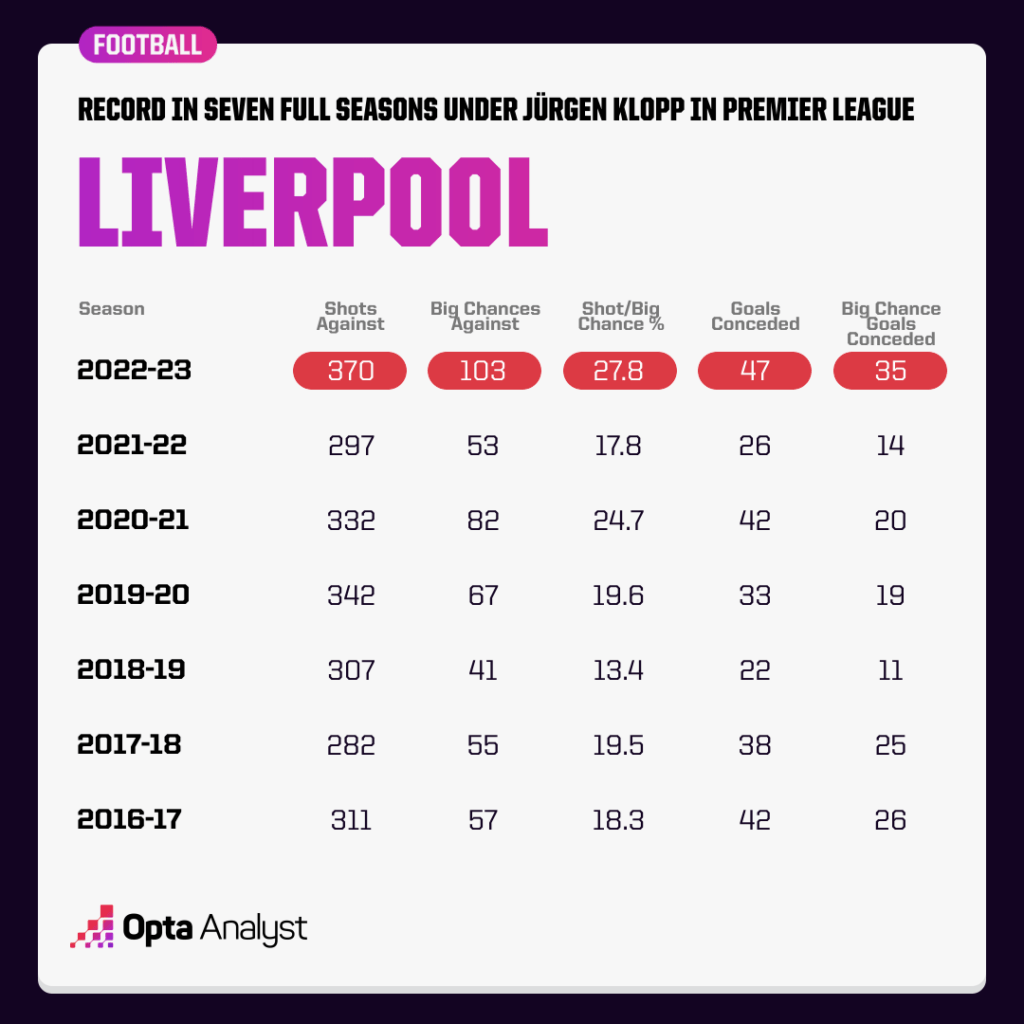
Without Alisson Becker in goal, who knows how bad things could have been for Liverpool?
Of those 103 big chances, just 35 found their way into the net (34.0%), with only four teams conceding fewer proportionally. Alisson made 108 saves in the Premier League in 2022-23, with only three other goalkeepers making more, at a percentage of 71.1 and from an expected goals on target conceded of 51.5. Compare that to the previous season when he was called on to make just 76 saves (76% save percentage) with an xGOT of 25.2, and it becomes clear how much less protection he got from his teammates. Overall, Alisson conceded 43 league goals. Removing two of those that were own goals, he prevented 10.5 goals from shots that were expected to go in. Only Fulham’s Bernd Leno (11.5) prevented more in the Premier League.
The former Roma man will be hoping to have far less to do in 2023-24.
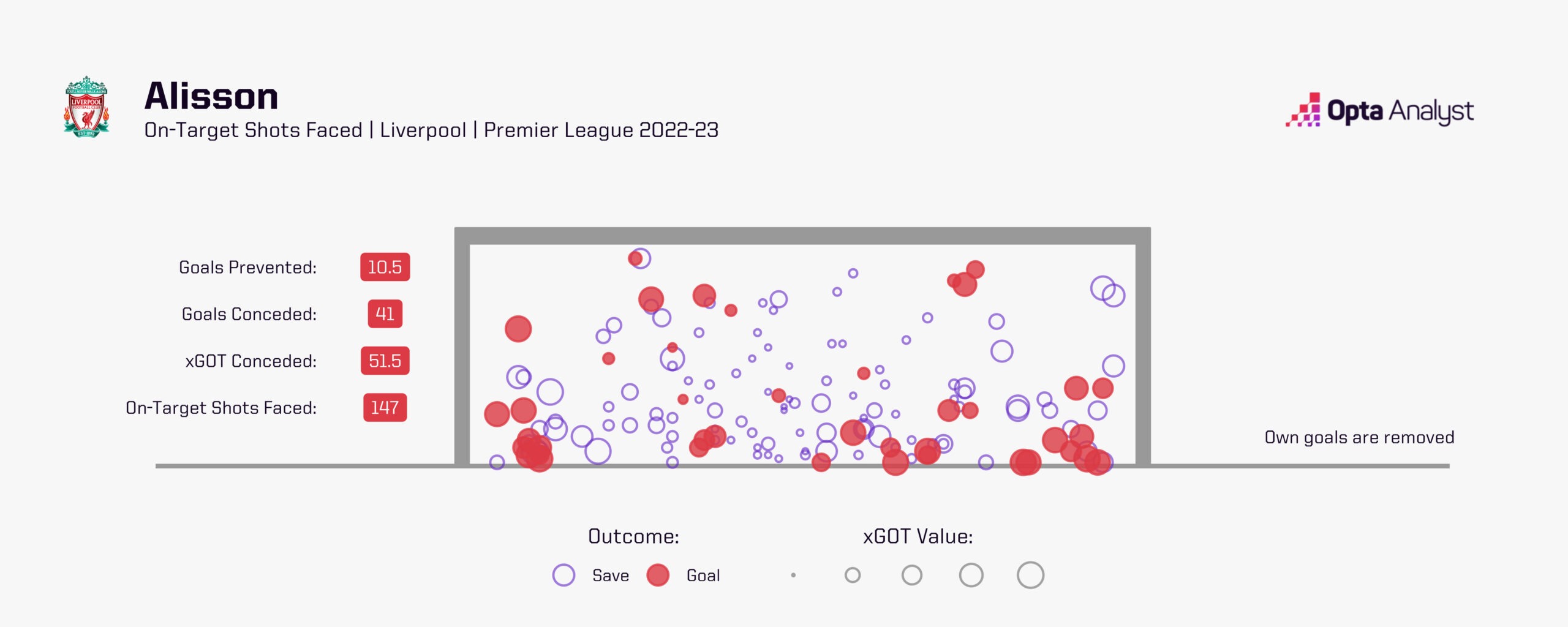
- A De-Pressing Season
If there’s one thing you would associate with Liverpool at their best, it’s their ferocious appetite to press teams high up the field. Klopp recently described it as the “ticket” to get into his team. It’s hardly surprising that they’ve topped the high turnover metric in the Premier League a few times in recent seasons, including 2021-22 (443), when they also scored the most goals from high turnovers (seven).
In 2022-23, they were second for high turnovers but well down on the previous season (368, behind Arsenal with 388) and scored just four times from them, with 10 teams managing more.
Then there was Liverpool’s duel success, or lack thereof. The year they won the Premier League (2019-20) they had the seventh highest percentage (50.6) but that fell to second worst in 2020-21 (47.8%), before a rise back to 49.2% in 2021-22 and then a drop to 47.5% in 2022-23, the worst in the league.
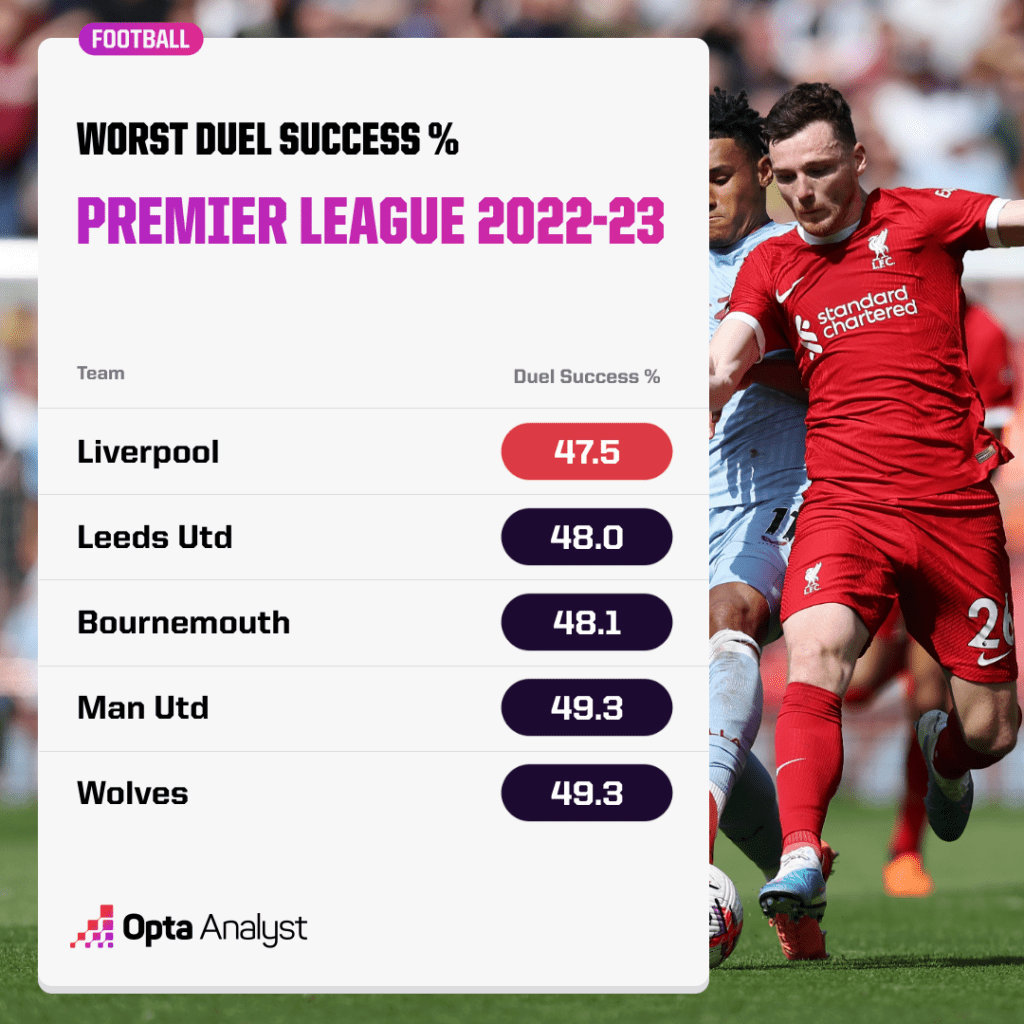
They were also struggling to beat the press as often. In 2021-22, they had the second fewest pressed sequences against (392) after Man City. This is the number of sequences starting in the opposition’s defensive third where a team has three or fewer passes before the sequence ends in their own half, suggesting that City and Liverpool were either not being pressed as much as other teams, or were simply better at beating it. That number rose from 392 to 458 for Liverpool in 2022-23, fourth in the league with City, Arsenal and Brighton all having fewer.
The midfield was in clear need of refreshment, which was not addressed in the 2022 summer transfer window. It was laid bare by the fact only Fabinho (31 starts) and Jordan Henderson (23) started more than half the league games, and both suffered significant drops in form.
Injuries to Thiago Alcântara, Curtis Jones, Naby Keïta, Alex Oxlade-Chamberlain and latterly youngster Stefan Bajcetic stopped Klopp from having a consistent midfield to call on, while loan signing Arthur Melo also sustained an injury shortly after arriving from Juventus and failed to feature at all even after he regained fitness. In total, the lesser-spotted Brazilian played 13 minutes for the club, all in that 4-1 loss at Napoli in the Champions League group stage after the game had already been lost.
As Liverpool’s form improved late on in the campaign, Jones finally put a run of games together that suggested he could have a big part to play next year if he can stay fit. If you discount Fábio Carvalho, who often played in a forward role, Jones was the only midfielder to score more than once in the league, with his three goals coming in wins over Tottenham and Leicester (two). Interestingly, his output profiles similarly to Manchester City’s Bernardo Silva, so much so that – according to Opta’s new player radars – the closest three profiles to Jones from recent seasons are all Silva.

Jones was not the only local player to impress in the final few weeks, though.
- Trenty’s Plenty
Few players were forced under the microscope this season more than Trent Alexander-Arnold. The ‘will-he, won’t-he?’ soap opera around his World Cup selection for England seemed to be entirely based on his defensive ability, which was the topic of debate on a seemingly weekly basis.
Statistically, Alexander-Arnold hadn’t done that much wrong. According to Opta numbers, he committed two errors that led to shots in the Premier League and none that led to goals prior to the home clash with Arsenal in early April. Only four Premier League defenders who had played at least 15 games had a better tackle success percentage than his 73.2, and he had a solid duel success percentage of 54, while he had been dribbled past by an opponent 20 times, 15 fewer than Newcastle United’s Kieran Trippier.
Those were just the surface numbers though, there was no doubt there had been too many occasions where Alexander-Arnold had been caught out at the back, though it was likely in part impacted by the inconsistency of the wider team.
Arguably the biggest concern about the 24-year-old’s performances were that his usually gigantic number of assists had almost disappeared, managing just two in his first 27 league outings. There was improvement, though, when Klopp decided in early April to move him into a hybrid position where he drifted into midfield when Liverpool had possession. The two maps below show just how different the two roles were.
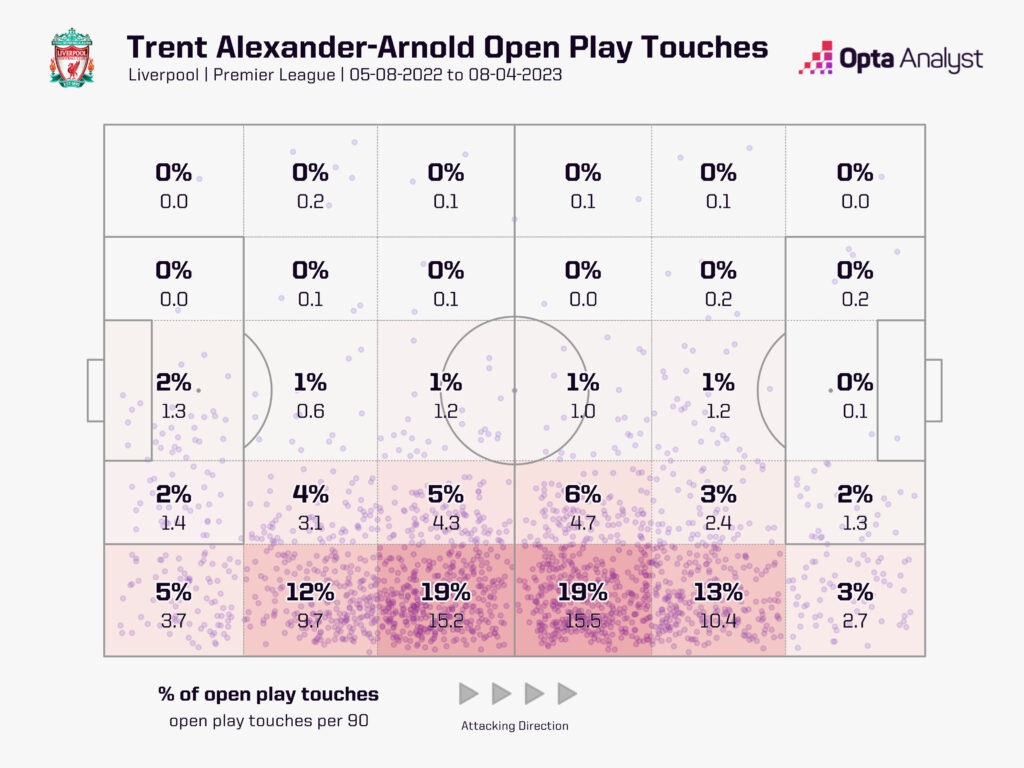
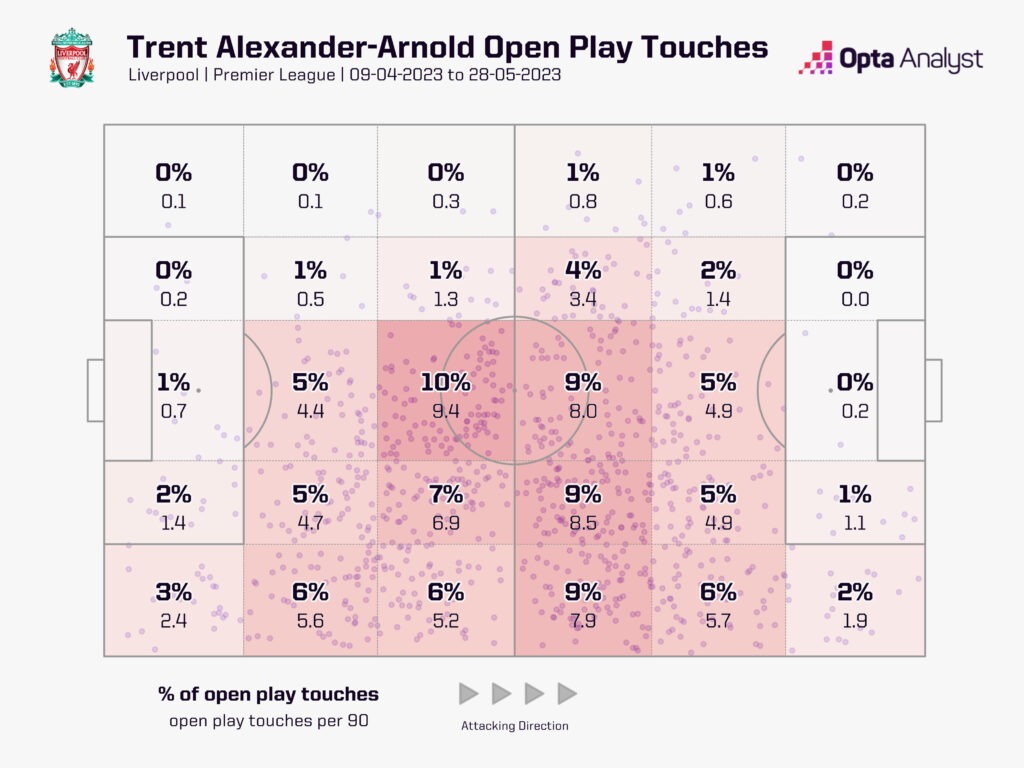
The experiment began in the 2-2 draw with Arsenal at Anfield, which included Alexander-Arnold setting up Firmino for a late equaliser. That was the first of seven assists in 10 games, while he also had the most touches of any player in the league in that period (1,073), 122 more than the next most, Brighton’s Lewis Dunk. Interestingly considering the criticism of his defending, he also boasted the second-most instances of possession won (80) behind only Manchester United’s Casemiro (89) in that time.
Alexander-Arnold’s rapid improvement coincided with Liverpool’s. Despite everything up to then, they won more points (24) than any side apart from champions Man City (25) across the last 10 games. It suggested that while they got a lot wrong in 2022-23, the future could still be bright for Klopp and Liverpool. Despite everything, they had enough about them to put the sort of winning run together that they frequently managed in previous, more successful campaigns, with certain key players finding their form after several months of playing well below par.
So, what will the key things be for Liverpool in 2023-24?
- Conclusion
The struggles of 2022-23 raised plenty of questions, with even Klopp’s position being questioned at times. The German coach acknowledged at one point that he probably would have been sacked by now had it not been for all the goodwill he had built up in previous seasons. A lack of investment in midfield, Núñez not hitting the ground running, asking a group of players who had played every game possible the previous season to go again, and the hangover from the Premier League and Champions League near-misses probably all played a factor.
The hope will be none of that will be the case next season. The one silver lining of a disappointing season in terms of cup competitions is they played significantly fewer games in 2022-23. The midfield has already started to finally be renovated with the addition of Alexis Mac Allister from Brighton and the potential for more this summer, while players like Núñez, Díaz and Gakpo will be looking to push on and contribute more if they can get a solid pre-season under their belts.
Gakpo showed in spells that he might be able to step into the significant shoes left by Firmino’s departure. He had nine goal involvements (G7 A2) from 21 Premier League games, having had 21 goal involvements (G9 A12) in 14 Eredivisie games prior to his move to Anfield. The Dutchman played centrally for Klopp rather than on the left as he did for PSV but seemed to be getting the hang of his role by the season’s end, often dropping deep and helping to link up play as the Brazilian forward had done so well for years.
Liverpool’s numbers will need to drastically improve both in defence and attack, but a refreshed midfield should help with what was a frayed team structure at times, while whatever happens with Alexander-Arnold’s role feels like it could make a huge difference, as it did towards the end of 2022-23.
Where Liverpool go from here will largely frame how the 2022-23 season is ultimately viewed. Either the beginning of the end for a once great team, or a bump in the road towards Klopp creating another great side.
